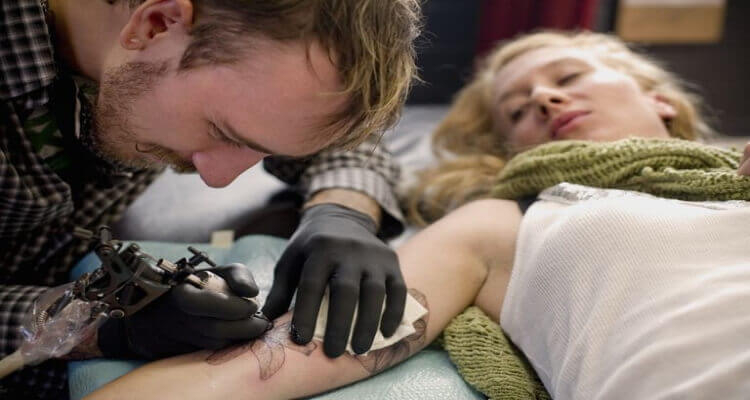Contents
When You are Getting a Tattoo What Does it Feel Like?

When most individuals want a new tattoo but imagine a multitude of needles puncturing in and out of their flesh thousands of times per minute, they usually imagine the worst. Many people believe that tattooing is a constant source of excruciating agony, although this isn’t always the case.
During a tattooing session, the average person will have a variety of sentiments, thoughts, and experiences, all of which will be influenced by a variety of circumstances. When getting a tattoo, everyone anticipates some level of pain or suffering.
The level of discomfort you experience will be determined by a number of factors, including your own pain tolerance and the tattoo’s location. Although pain is subjective, a tattoo pain chart can help you estimate how much a tattoo will hurt.
Fatty portions of the body, such as the upper arms, are likely to pain less than bonier body sections, such as the hands, rib cage, or any joints. Other sensations, such as tingling, itching, and pressure, are likely to accompany the pain.
The feeling of getting a Tattoo:
People may have varying experiences obtaining tattoos depending on the location of the tattoo and their pain tolerance. The person may experience burning or stinging when the tattooist injects ink into the skin using the tattoo instrument.
With the tattoo instruments, the tattooist creates the outline of the tattoo design, then shades in some places with color or contrast, depending on the design. Some individuals say outlining hurts more than shading, although everyone’s tattooing experience is different.
Throughout the tattooing procedure, discomfort might come and go in varying degrees. Some people compare the sensation to a prickling or a vexing scratch. When the tattooing needle comes into intimate contact with bone, it might cause a rattling or shaking sensation.
The pain usually starts out quite intense for several minutes at the start of the session, but once your body reacts by releasing various pain-dulling hormones in response to the needles pumping in and out of your skin, the affected area usually becomes slightly numb, and the pain goes away for a while, before returning in waves of varying length and intensity throughout the session.
Usually, the agony gets stronger as it gets closer to the finish. This is when you’re most likely starting to feel fatigued and fed up, and the pain-relieving hormones are running out. This is the phase where you must give it your all and persevere until you reach the finish line. After all, once the agony becomes unbearable, you’re generally almost there.
It’s also worth noting that distracting yourself with numerous distractions can frequently assist to divert your attention away from the pain and make the tattooing process more comfortable. Along with diversion tactics, the individual getting tattooed’s general mindset might have an impact on how painful the next session is.
Why does getting a Tattoo hurt?
Tattoo artists inject ink into the dermis layer of the skin with needles. Although medical methods such as laser treatment can erase a tattoo from the skin, this kind of tattooing is permanent.
When tattoo ink is applied to the dermis layer of the skin, it destroys it and generates blood clots, which results in bruising. To avoid infection, the person must take care of the tattooed region after it has been completed.
The injured skin swells up after having a tattoo. This is the body’s natural technique for preventing further harm to the skin and assisting in its healing. This swelling, on the other hand, can make the area more unpleasant or tender.
How does it feel after the Tattoo Session?
You’ll undoubtedly feel a huge feeling of relief once you’re done getting tattooed, thanks to those great endorphins and adrenaline. When it’s all said and done, you could even feel a little “high” when the adrenaline wears off, you relax a little, and you take a look at the art that’s now forever inscribed on your flesh. However, you may suffer some tenderness at the tattoo site in the hours, days, and even weeks afterward.
Feelings while getting a Tattoo on various parts of the body:
1. Forearms and calves; The forearms and calves have more fat and fewer nerve endings than the rest of the body. When getting either of these body regions tattooed, you should anticipate feeling mild to moderate pain.
2. Ankles, shins, and rib cage: Thinner layers of skin cover the bone in the ankles, shins, and rib cage. Because there isn’t much tissue to cushion the needle in these locations, getting tattooed can be extremely painful.
3. Upper and lower back: Although the back appears to be uncomfortable to tattoo, the skin is actually quite thick and has few nerve endings. Back discomfort is predicted to range from mild to moderate.
4. Hands, fingers, feet, and toes: Many individuals prefer the aesthetic of tattoos on their hands and feet, but because the skin is thinner and there are so many nerve endings in these areas, tattoos can be rather painful.
5. Shoulders, biceps, and thighs: On the tattoo pain scale, the shoulders, biceps, and thighs are three sites that rank quite low. There’s greater room between the needle and the bone, and there aren’t as many nerve endings.
Final Verdict:
Getting a new tattoo is a very personal experience, and it doesn’t have to be excruciatingly painful. Yes, you are likely to experience some discomfort during your session, but everyone is different, and most people don’t suffer as much as they anticipated.
The amount and type of pain you experience will vary based on a number of factors, including the tattoo’s location, type, skin sensitivity, and general pain tolerance. While a tattoo may burn or sting for up to a week following the process, if the pain is growing worse or your tattoo is oozing pus, consult your doctor.
